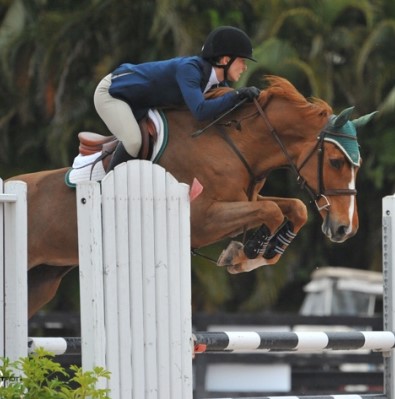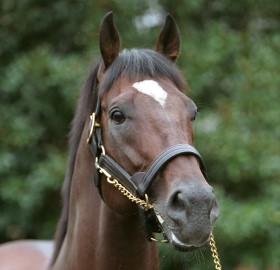 Once young colts and fillies reach the age of puberty their behavior may become an issue in the show ring or on the race track. Castrating a colt which you intend to use for breeding purposes may not be an option and mares are not typically permanently sterilized. Their sexual behavior may also cause problems with housing, trail riding, etc. In this article, Dr. Ed Squires discusses some of the common ways stallion and mare owners suppress the behavior of their horses.
Once young colts and fillies reach the age of puberty their behavior may become an issue in the show ring or on the race track. Castrating a colt which you intend to use for breeding purposes may not be an option and mares are not typically permanently sterilized. Their sexual behavior may also cause problems with housing, trail riding, etc. In this article, Dr. Ed Squires discusses some of the common ways stallion and mare owners suppress the behavior of their horses.
Suppression of Stallion Sexual Behavior
As stallions reach the age of puberty they develop their sexual behavior and can become aggressive. The approach that has been used most often for suppressing sexual and aggressive behavior in stallions is by suppressing the hormone testosterone. This is thought to be the hormone responsible for sexual behavior in stallions. The progesterone-like compound, Altrenogest (brand name Regumate) has been shown to lower testosterone levels and suppress sexual behavior in stallions. In one study at Colorado State University approximately 20 ml of Regumate was given to mature stallions for 150 days; testis size, sperm numbers, LH hormone levels and sexual behavior were suppressed in these stallions. Obviously, the concern is whether the stallions will recover once the hormone treatment is discontinued. For this group of mature stallions most of the reproductive parameters, including sexual behavior, did return to normal by 4-5 months after the last hormone treatment. However, we suspect that treatment of stallions that are weanlings or yearlings with this same treatment may cause some permanent effects.
 Other approaches that have been used to lower sex drive in stallions is the use of a gonadotropin releasing hormone (GnRH) agonist or antagonist. The GnRH agonist initially stimulates a large increase of the hormone LH but when continually given a GnRH agonist will eventually decrease LH and testosterone. The GnRH antagonist works by inhibiting the binding of natural GnRH to its receptor and thus the levels of LH are reduced which eventually lowers the level of testosterone that the stallion produces. Although both of these approaches have been shown to work under experimental conditions they are not practical for the following reasons: they are too expensive, the GnRH agonist and antagonist are not readily available and the return to normal function after treatment can be quite variable.
Other approaches that have been used to lower sex drive in stallions is the use of a gonadotropin releasing hormone (GnRH) agonist or antagonist. The GnRH agonist initially stimulates a large increase of the hormone LH but when continually given a GnRH agonist will eventually decrease LH and testosterone. The GnRH antagonist works by inhibiting the binding of natural GnRH to its receptor and thus the levels of LH are reduced which eventually lowers the level of testosterone that the stallion produces. Although both of these approaches have been shown to work under experimental conditions they are not practical for the following reasons: they are too expensive, the GnRH agonist and antagonist are not readily available and the return to normal function after treatment can be quite variable.
Lastly, in some countries but not the USA, GnRH vaccines are available. These vaccines can be given and then a booster a few weeks later which will result in antibody formation against the GnRH in the stallion or mare. These antibodies bind up the natural GnRH and then lower LH levels and subsequently testosterone levels. The vaccines have been given to both mares and stallions in Europe and Australia. The biggest drawback is the potential for injection site reaction as well as the not knowing when the effects of the vaccines will wear off and if the animals will return to normal reproductive function.
Suppression of Mare Sexual Behavior
Suppression of sexual behavior in mares is much more common than in stallions. It is generally accepted that when mares are in estrus (heat) there performance may not be as good as when they are out of heat. By far, the most common treatment is the administration of altrenogest (Regumate or a generic such as Altresyn, Altren, or OvaMed). These products are given daily as an oral preparation for as long as desired. Mares have been given Regumate for up to 60 days and then bred with no adverse effect on fertility. If the owner does not want to give the oral altrenogest daily, there are injectable altrenogest products that are compounded. One is designed to last 7- 10 days and the other is a 30 day treatment. The papers published on these have demonstrated good efficacy.
Although, giving a GnRH agonist and antagonist can prevent a mare from expressing estrus they are not commonly used in mares. GnRH vaccines have also been used in mares in other countries but are not available for use in the United States.
 A few additional options to suppress estrus behavior in mares are the use of Oxytocin and marbles. Frequent injection of oxytocin has been shown to alter the mares cycle and to keep her out of heat. However, the injections must be given at specific stages of the cycle and for several days which makes this approach less than ideal. Marbles can be placed in the mare’s uterus to suppress estrus. The marble is used to mimic the presence of a real embryo which decreases the amount of prostaglandins she produces and allows for the increase of progesterone thus keeping her out of heat. I am generally opposed to this treatment since some of these marbles are left in the mare to long and cause uterine problems. In addition, the one study on the use of marbles showed that < 50 % of the mares responded to this treatment by staying out of heat.
A few additional options to suppress estrus behavior in mares are the use of Oxytocin and marbles. Frequent injection of oxytocin has been shown to alter the mares cycle and to keep her out of heat. However, the injections must be given at specific stages of the cycle and for several days which makes this approach less than ideal. Marbles can be placed in the mare’s uterus to suppress estrus. The marble is used to mimic the presence of a real embryo which decreases the amount of prostaglandins she produces and allows for the increase of progesterone thus keeping her out of heat. I am generally opposed to this treatment since some of these marbles are left in the mare to long and cause uterine problems. In addition, the one study on the use of marbles showed that < 50 % of the mares responded to this treatment by staying out of heat.
Conclusion
In summary, the mare and stallion owner should consult with their veterinarian before attempting to use hormones to alter the normal sexual behavior in mares and stallions. They should take into consideration how long they want to suppress behavior and how soon after the end of the treatment they intend to attempt to breed the mare and/or stallion. Many of the approaches mentioned above have potential long-term effects on the behavior of mares and stallions and should be used with care. However, if properly designed in combination with your veterinarian they may allow you to have a more successful and pleasurable time showing your mare or stallion.
Photo of jumping mare provided by Matty O'Rourke


Log in to join the conversation.